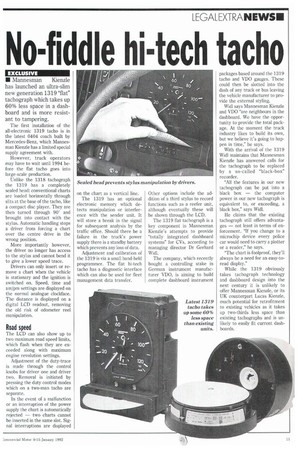No-fiddle hi-tech tacho
Page 13

If you've noticed an error in this article please click here to report it so we can fix it.
EXCLUSIVE
• Mannesman Kienzle has launched an ultra-slim new generation 1319 "flat" tachograph which takes up 60% less space in a dashboard and is more resistant to tampering.
The first installation of the all-electronic 1319 tacho is in the latest 0404 coach built by Mercedes-Benz, which Mannesman Kienzle has a limited special supply agreement with.
However, truck operators may have to wait until 1994 before the flat tacho goes into large-scale production.
Unlike the 1318 tachograph the 1319 has a completely sealed head: conventional charts are loaded horizontally through slits at the base of the tacho, like a compact disc player. They are then turned through 90' and brought into contact with the stylus. Automatic handling stops a driver from forcing a chart over the centre drive in the wrong position.
More importantly however, the driver no longer has access to the stylus and cannot bend it to give a lower speed trace.
Drivers can only insert or remove a chart when the vehicle is stationary and the ignition is switched on. Speed, tune and am/pm settings are displayed on the normal analogue clockface. The distance is displayed on a digital LCD readout, removing the old risk of odometer reel manipulation.
Road speed
The LCD can also show up to two maximum road speed limits, which flash when they are exceeded along with maximum engine revolution settings.
Adjustment of the duty-trace is made through the control knobs for driver one and driver two. Removal is initiated by pressing the duty control modes which on a two-man tacho are separate.
In the event of a malfunction or an interruption of the power supply the chart is automatically rejected — two charts cannot be inserted in the same slot. Signal interruptions are displayed on the chart as a vertical line.
The 1319 has an optional electronic memory which detects manipulation or interference with the sender unit. It will store a break in the signal for subsequent analysis by the traffic office. Should there be a failure in the truck's power supply there is a standby battery which prevents any loss of data.
Adjustment and calibration of the 1319 is via a small hand-held programmer. The flat hi-tech tacho has a diagnostic interface which can also be used for fleet management data transfer. Other options include the addition of a third stylus to record functions such as a reefer unit, although eventually these will be shown through the LCD.
The 1319 flat tachograph is a key component in Mannesman Kienzle's attempts to provide "totally integrated dashboard systems" for CVs, according to managing director Dr Gerhard Widl.
The company, which recently bought a controlling stake in German instrument manufacturer VDO, is aiming to build complete dashboard instrument packages based around the 1319 tacho and VDO gauges. These could then be slotted into the dash of any truck or bus leaving the vehicle manufacturer to provide the external styling.
Widl says Mannesman Kienzle and VDO are neighbours in the dashboard. We have the opportunity to provide the total package. At the moment the truck industry likes to build its own, but we believe it's going to happen in time," he says.
With the arrival of the 1319 Widl maintains that Mannesman Kienzle has answered calls for the tachograph to be replaced by a so-called "black-box" recorder.
"All the features in our new tachograph can be put into a black box — the computer power in our new tachograph is equivalent to, or exceeding, a black box," says Widl.
He claims that the existing tachograph still offers advantages — not least in terms of enforcement. "If you change to a microchip device every police car would need to carry a plotter or a reader," he says.
"The chart is foolproof, they'll always be a need for an easy-toread display."
While the 1319 obviously takes tachograph technology and dashboard design into the next century it is unlikely to offer Mannesman Kienzle, or its UK counterpart Lucas Kienzle, much potential for retrofitment to existing vehicles as it takes up two-thirds less space than existing tachographs and is unlikely to easily fit current dashboards.
































































